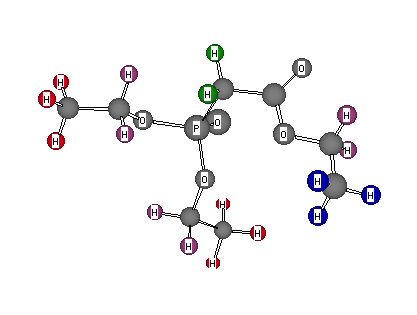Formula: C8H17PO5
Answer: Triethyl phosphonoacetate
Chemical Shift Assignment:
1H NMR: δ 4.17 (6H, m), 2.97 (2H, d, J = 20 Hz), 1.35 (6H, t, J = 7 Hz), and 1.29 (3H, q, J = 7 Hz)
13C NMR: 165.7 (d, J = 6 Hz), 62.6 (d, J = 6 Hz), 61.4, 34.3 (d, J = 134 Hz), 16.4 (d, J = 7 Hz), and 14.1.
Phosphorus is present in this compound and coupling between 31P (abundance = 100%) should be anticipated. The large J value of 20 Hz in the 1H NMR spectrum is indicative of 1H-31P coupling as are the couplings in the 13C NMR spectrum telltale signs of 13C-31P coupling. The 3H triplets at δ 1.35 and 1.29 are methyl groups attached to three unresolved methylene groups at δ 4.17. [Note: Of the six hydrogens colored violet four are of a lighter shade and two are a darker shade. The matched pair in the ester group are enantiotopic. The two mismatched pairs are diastereotopic, a fact that may add to the complexity of the signal.] The shift of the methylene groups indicate that they are attached to oxygen atoms. Two of the C2H5O- groups are identical from the integration. C6H15O3 has been determined; C2H2PO2 remains. The remaining two equivalent hydrogens are at δ 2.97 in the 1H NMR spectrum and they are coupled by 20 Hz to phosphorus. This means that the CH2 group is attached to phosphorus and that the carbon is the one at 34.3 ppm (J = 134 Hz). The CH2 is also attached to a carbon atom based on its chemical shift. The unknown assignments are CPO2. The doublet (J = 6 Hz) at 165.7 ppm is in agreement with an ester carbonyl carbon. All that remains to be assigned is PO. It is possible that the phosphorus is trivalent and that the remaining oxygen is part of a perester, or a P=O bond is present. A 31P NMR would distinguish these two options. Working on the assumption that a P=O bond is present, we have P(=O)CH2CO to which the three C2H5O groups must be attached. Return to Menu.
 |
oxygen-yellow phosphorus-orange
|
|---|